The Art of Science—Versailles at the Science Museum, London
Have you ever wondered how it would feel to witness the grandeur and opulence of the 18th-century French court? Then you might want to go to London.
Edoardo Cesarino 19 December 2024
22 December 2023 min Read
Jean-Michel Basquiat: King Pleasure is an immersive art experience organized in Los Angeles by the family of the artist in a space designed by the architect Sir David Adjaye OBE. The exhibition, which was previously presented in New York City, has been extended in Los Angeles till the end of the year. King Pleasure is a celebration of Basquiat’s life, one that encompasses not only his high-profile professional success but also commemorates his childhood, family, and formative experiences.
Over the past three decades and since the artist’s untimely death, the excitement around his art and life has grown exponentially given the staggering amount of work produced over a short period of time and his prominence among the thriving downtown Manhattan art scene of the 1980s. Jean-Michel Basquiat has rightfully earned a respected place within the academic art world but he is also well-known and celebrated across mainstream, international, and multigenerational audiences. Under the direction of the artist’s estate, which is managed by Basquiat’s younger sisters Lisane Basquiat and Jeanine Heriveaux, and stepmother Nora Fitzpatrick, King Pleasure is playful, nostalgic, and acknowledges Basquiat’s widespread appeal.
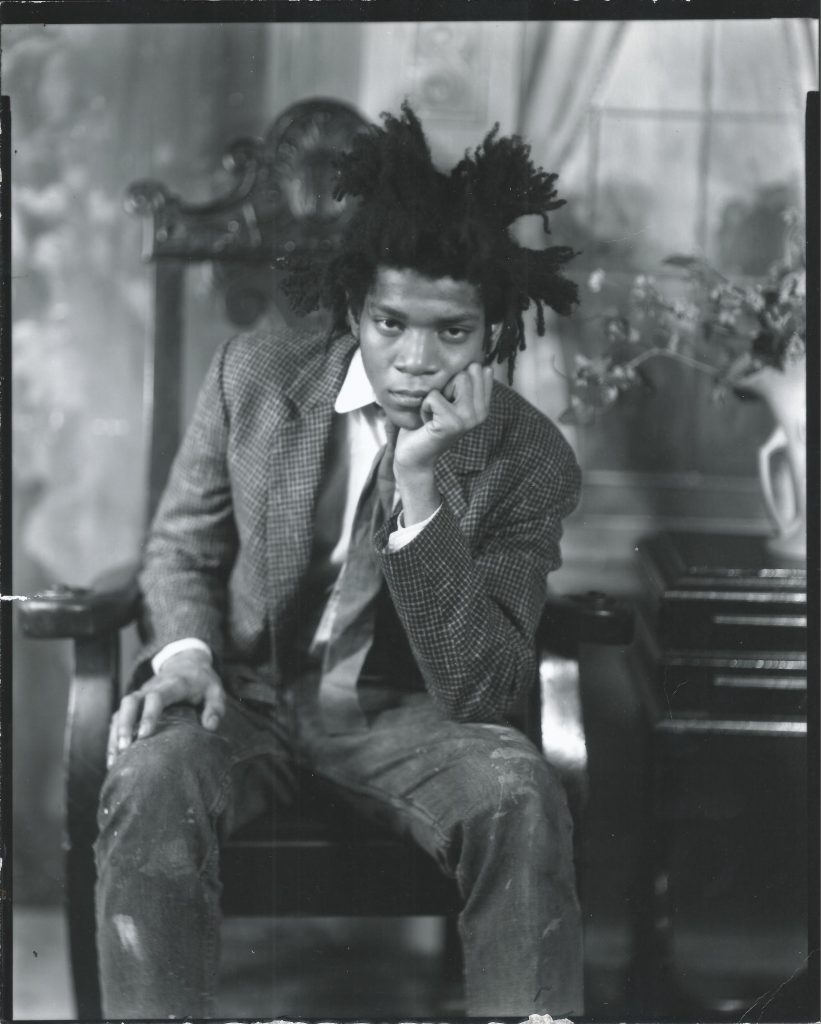
Jean-Michel Basquiat, 1982, © James Van der Zee Archive, The Metropolitan Museum of Art, New York, NY, USA.
There is a lot to digest when looking at the art of Jean-Michel Basquiat (1960-1988) who was just a young man processing his own place in this world. His expressive paintings expertly mix together bold colors, raw imagery, and a profusion of text referencing histories, his athletic and musical heroes, current events, and Basquiat’s own sense of self as an Afro-Caribbean male artist coming of age in New York City during the 1980s.
Recurrent images such as a three-point crown and roughly drawn heads and figures appear in dense and vast fields of color and text across large paintings but also in small and sparse works on paper. Basquiat left behind a treasure trove of visually pleasing compositions that are filled with razor-sharp and quick-witted social commentaries that have given scholars plenty to write about throughout the years and will continue to hold the attention of future generations.
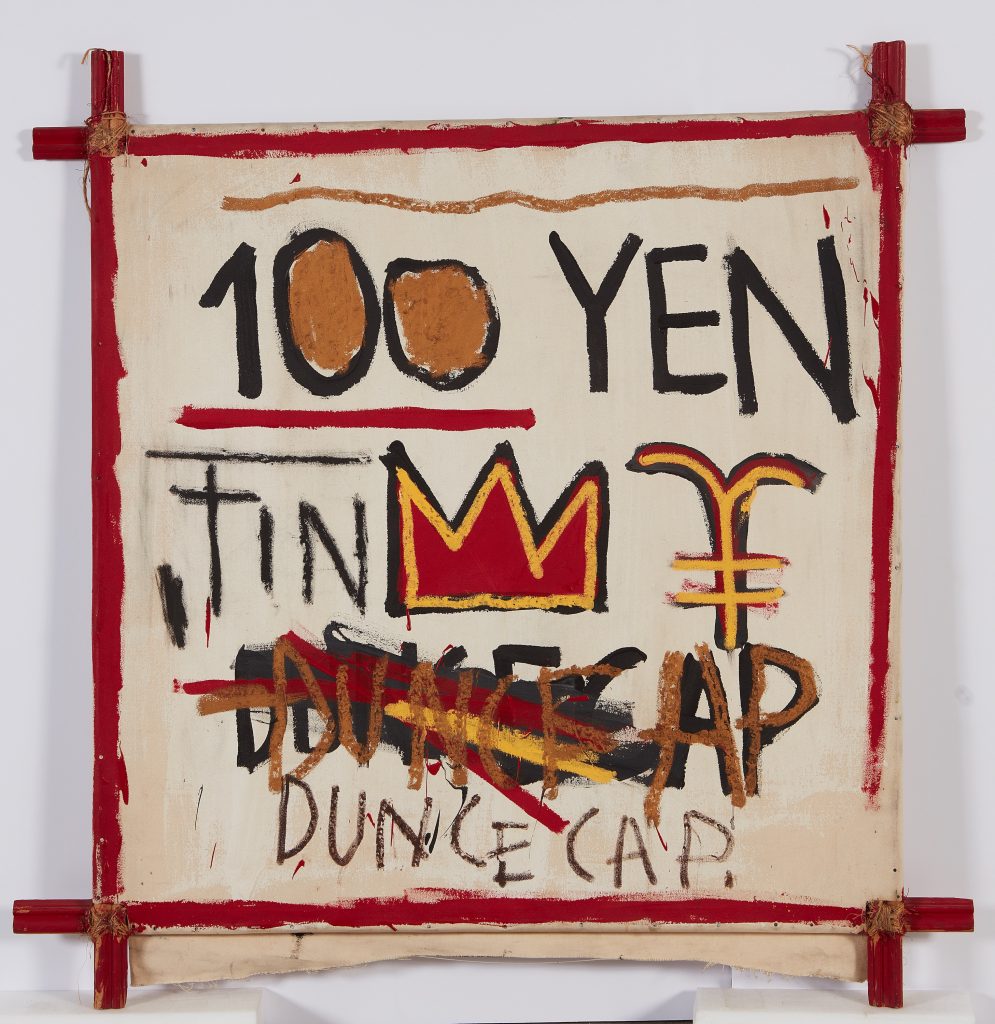
Jean-Michel Basquiat, Untitled (Thor), 1982 © The Estate of Jean-Michel Basquiat Licensed by Artestar, New York, NY, USA.
The story of Basquiat’s rapid rise to fame is well known and one that generally originates around 1978 when he left his family’s home in Brooklyn for Manhattan where he very quickly found his way into the underground music and art scene of downtown Manhattan. Concurrent with the rise of graffiti art and hip-hop, Basquiat emerged as SAMO, the graffiti tag name that appeared next to lines of text written by the young artist on buildings around town.
During this period, Basquiat was briefly part of a punk/noise band called Gray, dated Madonna before she was famous, and was friends with Fad 5 Freddy (Freddy Braithwaite), who was at the nexus of the burgeoning hip hop scene uptown and the downtown club and art scene. Of the long list of celebrities and accomplished individuals within Basquiat’s orbit, his friendship/mentorship with Andy Warhol is probably one of the most emphasized and discussed relationships.
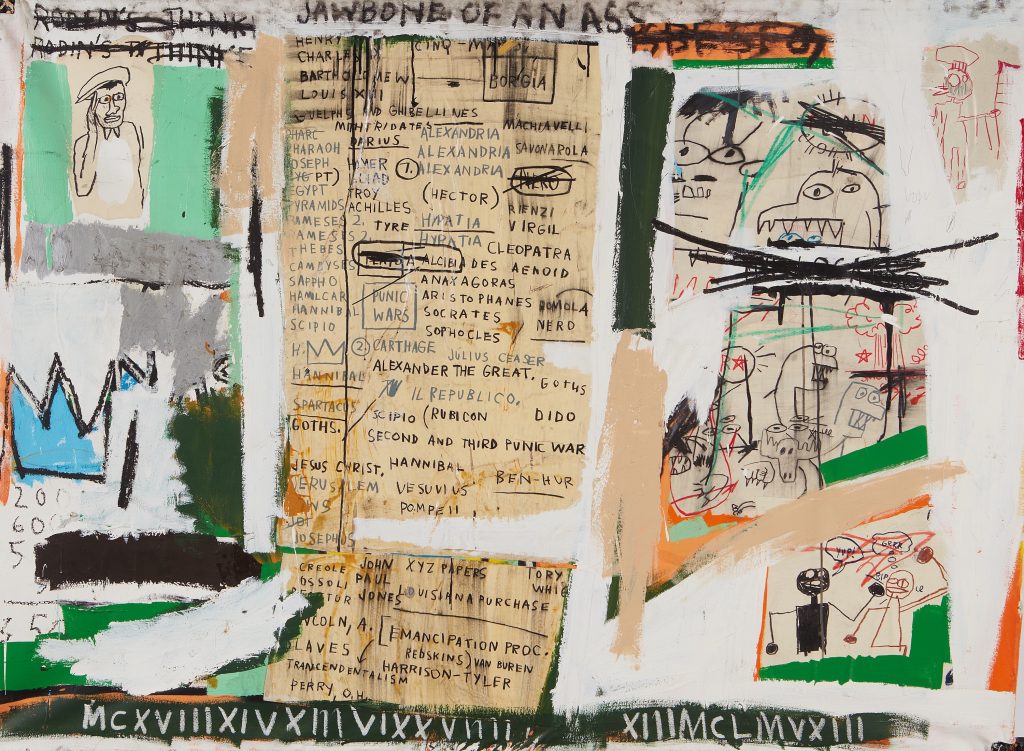
Jean-Michel Basquiat, Jawbone of an Ass, 1982 © The Estate of Jean-Michel Basquiat Licensed by Artestar, New York, NY, USA.
Basquiat’s art career took off shortly after his work was included in the Times Square Show (1980) and New York/New Wave (1981) exhibitions. This exposure led to his first solo show at Annina Nosei Gallery followed by another solo show at Gagosian Gallery in Los Angeles, inclusion in Documenta 7 in Kassel, Germany, and another solo show at Galerie Bruno Bischofberger in Zurich – all in 1982. Until his death in 1988, Basquiat’s continuous output kept pace with his rapid success because he was able to work exclusively as an artist who was recognized locally and globally.
The whirlwind of events that make up such a short span of time has overshadowed the artist’s relationships with his family; personal and meaningful connections that continued after he left home in 1978. King Pleasure is a complete look at a life that takes into account the formative years and the lasting impact of family relationships. Basquiat’s younger sisters, Lisane Basquiat and Jeanine Heriveaux, and stepmother, Nora Fitzpatrick, have taken this opportunity to expand and enrich Basquiat’s legacy as more than an untrained artist that was suddenly sprung from the underground art scene because he ran with the “it” crowd or was plucked from the streets of New York City by an art dealer.
In the exhibition catalog, Lisane Basquiat makes a point of clarifying that the relationship between her brother and Andy Warhol was a mentorship/friendship, one of mutual respect between peers despite the age difference, and that suggestions of a father/son dynamic are not only inaccurate but suggestive of a void in Basquiat’s life. King Pleasure’s integration of Basquiat’s family history into the overall narrative of his life and career seeks to present a more complete picture of the artist’s personal growth of development.
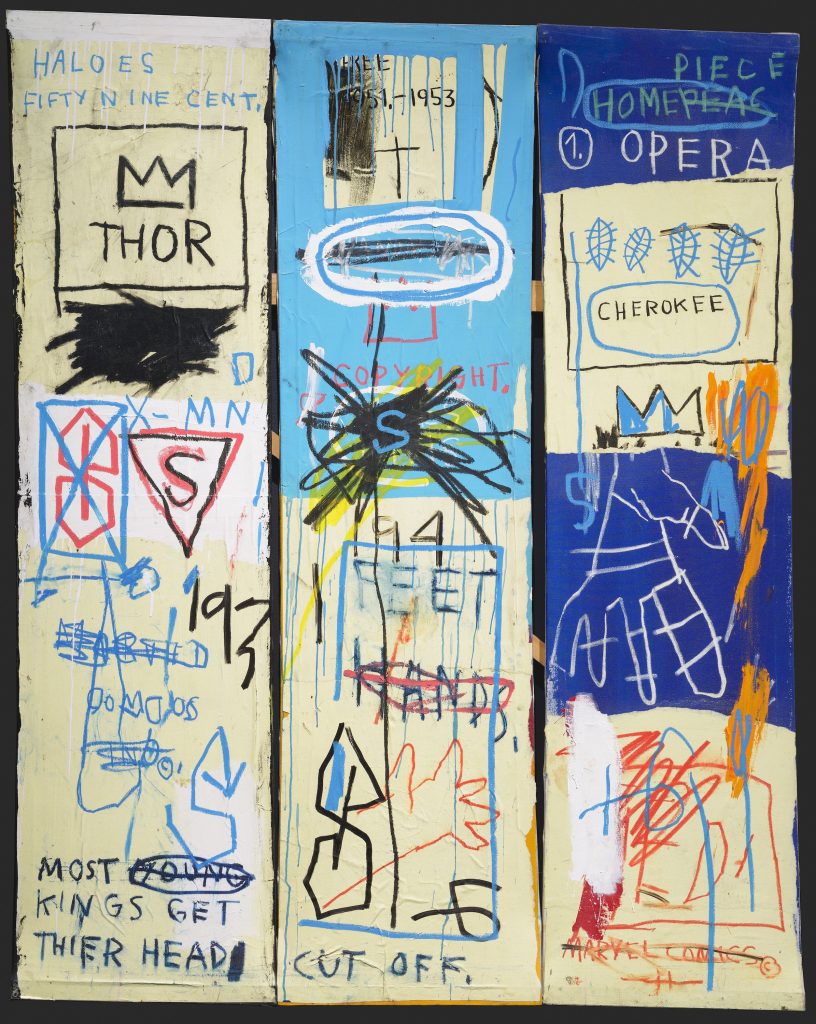
Jean-Michel Basquiat, Charles the First, 1982 © The Estate of Jean-Michel Basquiat Licensed by Artestar, New York, NY, USA.
What is important for everyone to understand, though, is that he was a son, and a brother, and a grandson, and a nephew, and a cousin, and a friend. He was all of that in addition to being a groundbreaking artist.
Jean-Michel Basquiat: King Pleasure, exhibition catalog, 2022, page 283.
Born to Matilde Andrades, who was Brooklyn-born but of Puerto Rican descent, and a Haitian father, Gerard Basquiat, Jean-Michel was the oldest of three children who grew up in a middle-class household in Brooklyn where they were surrounded by a large network of extended family. His parents separated when he and his sisters were young and although the children lived full-time with their father, they continued to see their mother on a regular basis.
Gerard and his three children lived briefly in Puerto Rico when Jean-Michel was a teenager. Following their return to Brooklyn, Nora Fitzpatrick joined their family when she moved in with Gerard and his children. The children maintained their relationships with their mother, Matilde, who was admitted to a mental institution for a period of time following the breakup of her marriage but who continued to live near her children at her own mother’s and their grandmother’s home.
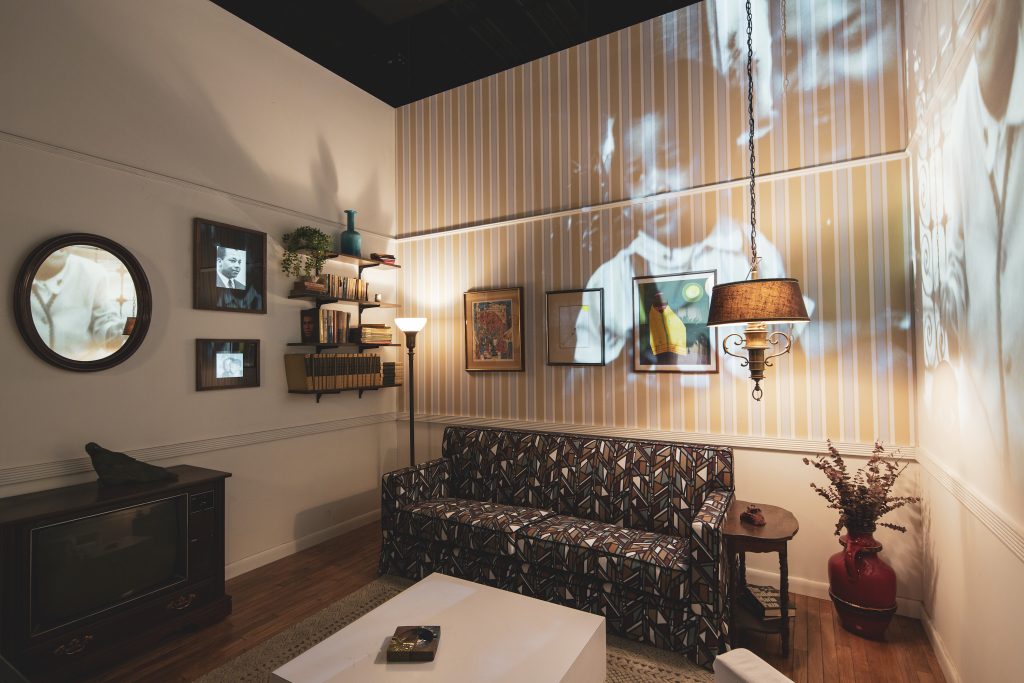
Installation view of Jean-Michel Basquiat: King Pleasure, New York, NY, USA. Photo by Ivane Katamashvili.
Their childhood, as described by Lisane and Jeannine in short videos throughout the exhibition and at length in the catalog, presented some challenges along the way but the family bonds remained strong. King Pleasure works hard to recreate their collective experiences through the inclusion of archival materials such as family photographs and home videos as well as the recreation of the living room and dining room from their family’s home in Brooklyn.
The intimate space of the home is physically and conceptually at the center of King Pleasure, an exhibition committed to the good times and an obvious attempt to downplay predominant discussions that emphasize/romanticize the hardships endured throughout Basquiat’s lifetime. Collective memories of a stable home life make for a different point of origin in the evolution of Basquiat who did not simply emerge from the streets of New York. King Pleasure incorporates the move away from the family in 1978 as a moment in Basquiat’s timeline that did not disrupt the connection between the artist and his family even though the following decade would be a period of tremendous highs and lows.
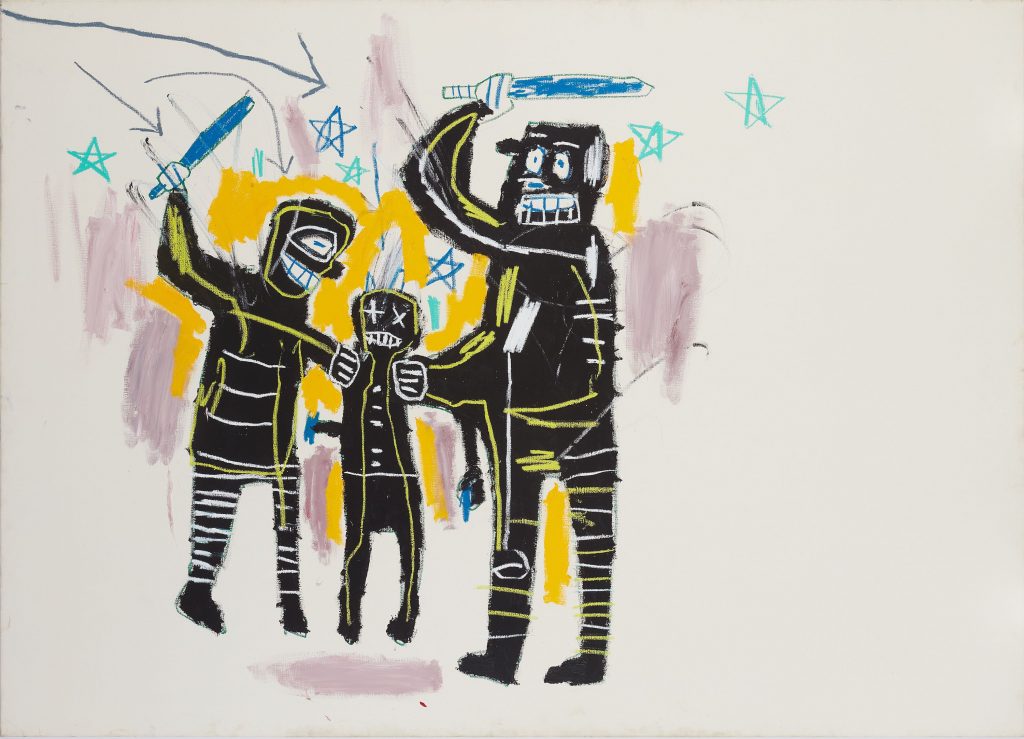
Jean-Michel Basquiat, Jailbirds, 1983. © The Estate of Jean-Michel Basquiat, New York, NY, USA.
The exhibition includes original art belonging to the Estate as well as a recreation of his studio space, an animation of his SAMO graffiti poetry on an outdoor space, and a large recreation of the Palladium nightclub. King Pleasure is a lighthearted and fun experience that touches very briefly on the details that led to Basquiat’s death at only 27 years old. This experience is celebratory and educational because it offers many opportunities for young visitors to connect with Basquiat at various stages in his life.
Not only was I transported back in time to when I first learned about Basquiat as a college student in the late 1990s but my nine-year-old daughter left excited about the art and life of Basquiat who she concluded must have been a fun person, someone who was loved by many. I think this is exactly what the family hopes for visitors to experience during their visit to King Pleasure.
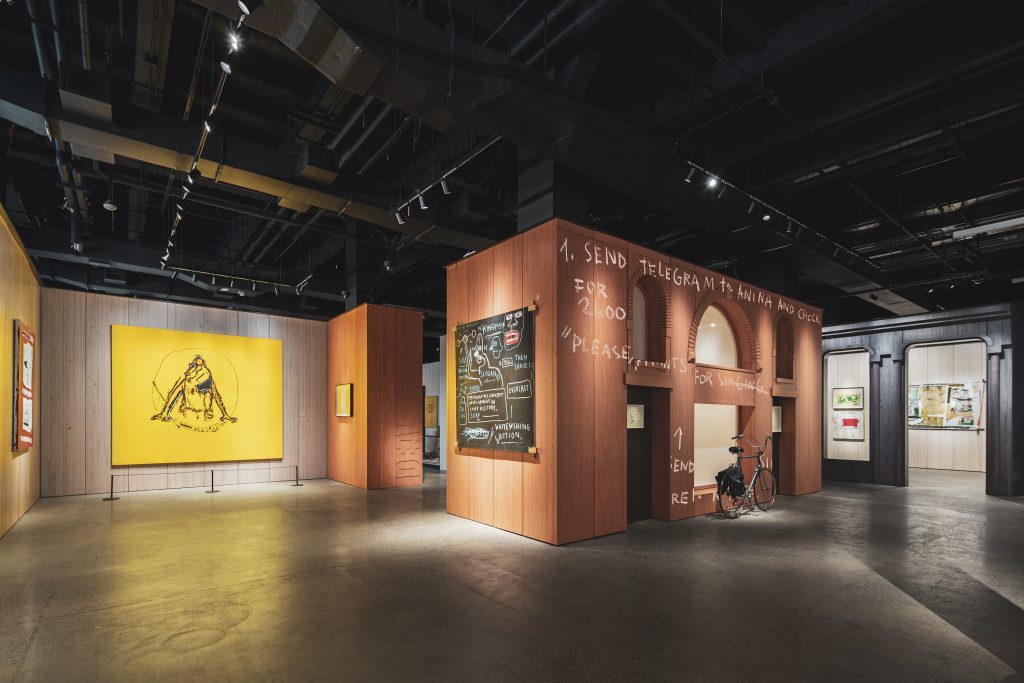
Installation view of Jean-Michel Basquiat: King Pleasure, New York, NY, USA. Photo by Ivane Katamashvili.
Get your tickets online to visit Jean-Michel Basquiat: King Pleasure, scheduled to run through January 1st, 2024 at the Grand LA, Los Angeles, CA, USA. Please check the website to learn more.
DailyArt Magazine needs your support. Every contribution, however big or small, is very valuable for our future. Thanks to it, we will be able to sustain and grow the Magazine. Thank you for your help!